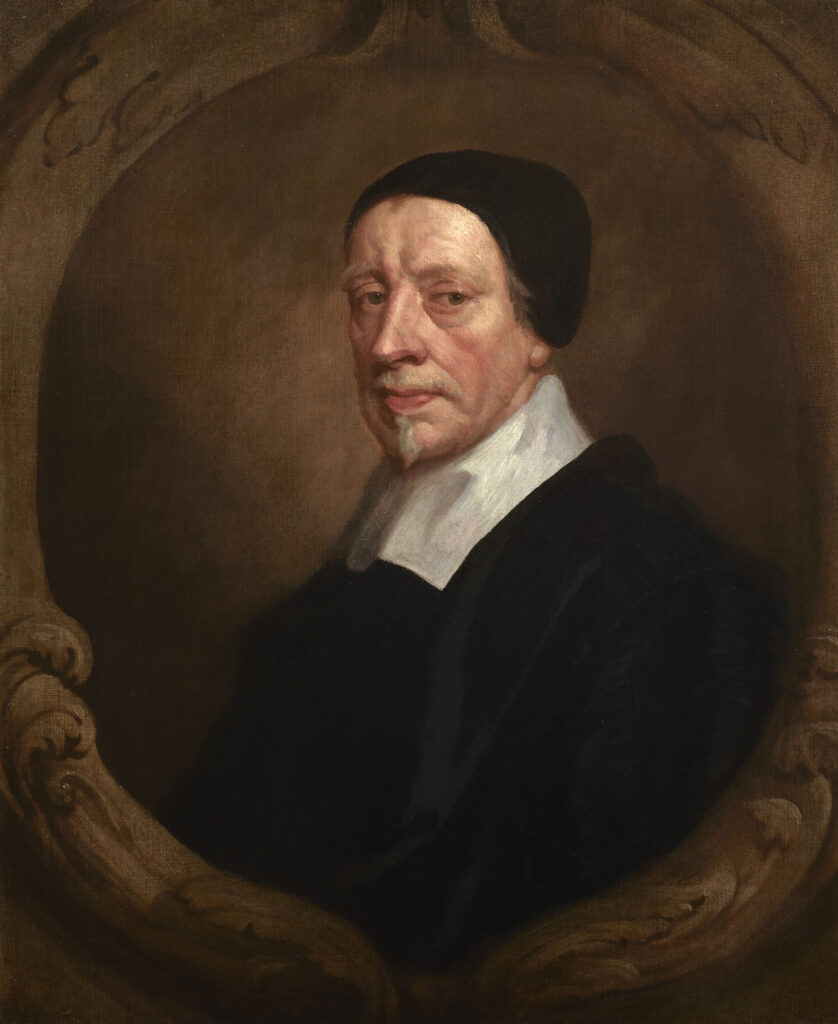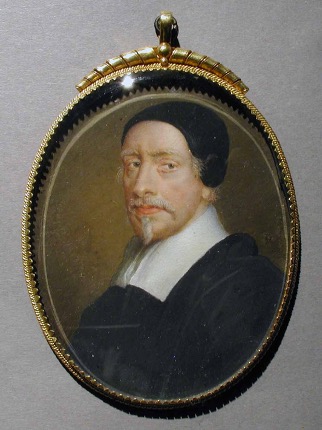Sir Peter Lely
1618 – 1680
Portrait of Edward Reynolds, Bishop of Norwich (1599-1676), in a Black Coat with a white Collar and a Skull Cap, in a painted Cartouche


Essay:
Peter Lely was born at Soest in Westphalia and trained in Haarlem. Although of Dutch origin, he spent almost all his career in England, arriving in or around 1643 and became naturalised as an English subject in 1662. Lely began his painting career in England by working on figure compositions in landscapes, but soon turned to the more profitable field of portraiture. Fortune smiled on him, for within a few years of his arrival in England some of the best portraitists had disappeared from the scene; Van Dyck and William Dobson died in 1641 and 1646 respectively, and Cornelis Johnson returned to Holland in 1643. Soon Lely was the most fashionable portrait artist in England.
Amongst his many portraits, Lely is known to have painted Charles I and his children, Oliver Cromwell and his son Richard, and other leading figures of the Interregnum, but he is associated chiefly with the Restoration Court of Charles II. He was made Principal Painter in Ordinary to Charles II in 1661 and was able to enjoy a lavish lifestyle, some of which is described in Samuel Pepys' diary: ‘a mighty proud man he is, and full of state.’
With the aid of his assistants he maintained an enormous output. His portraits of serene, glamorous ladies and regal courtiers have created the popular image of Restoration England. He was a fluent and lively colourist and had a gift for impressive compositions. Van Dyck’s legacy passed to Lely who completely dominated portraiture in his time. During his career Lely amassed one of the finest collections of Old Master drawings which are today identifiable by his distinctive PL monogram stamp.
This recently discovered portrait by the renowned painter Sir Peter Lely is the original version of a portrait which belongs to The Royal College of Physicians (called 'Studio of Lely'). In the College's portrait the sitter has traditionally been identified as William Harvey (1587 - 1657) the celebrated English physician.
However, this identification has been called into question due to physiological differences between the sitter and definitely known images of Harvey, such as a portrait by an unknown artist in the Royal Society (RS.9274). Moreover, stylistically the present portrait can be dated to c.1670 while Harvey died in 1657. The cartouche is also typical of Lely from around 1670.
The identity of the sitter is rather Edward Reynolds, Bishop of Norwich (1599 – 1676). The sitter’s identity can be claimed from a portrait miniature in the Carnegie Museum of Art which appears to have been copied from the present picture (see fig. 1). The manner of dress is typical of a clergyman from this time. A version of the portrait (current location unknown) is recorded in the Heinz Archive as belonging to the Brewster family who lived in Wrentham Hall until 1797, only 45 miles from Norwich. It is possible that this is a third large-scale version of this portrait, or it could perhaps be the present picture.
Born in Southampton, Edward Reynolds had a lifelong career in the Anglican Church starting as Preacher at Lincoln’s Inn. Rising through the ranks of the clergy he was made vicar of St. Lawrence Jewry in London from 1645-1662 and was made a dean of Christ Church College Oxford in 1648. During the Civil War Reynolds allied himself politically with the Presbyterian faction and was ejected from Oxford for this stance, although he was known to be moderate in his religious beliefs. The diocese of Norwich was abolished during the Cromwellian period and once it was reinstated in the Restoration Reynolds was consecrated as bishop on 13 January 1661 and retained the position until his death. As an Anglican Reynolds was able to marry and had a son Edward, who also joined the church, and a daughter Elizabeth.
Portrait of Edward Reynolds exhibits Lely's utter mastery of his medium and the portrait genre. Thin, creased skin over the forehead suggests the shape of the bones beneath while slick highlights indicate alert, watery eyes. Dry brushwork, confident flourishes, and diagonal hatching over the skin are typical of Lely at his best in this late period. A similar portrait from this period, also of a bishop and also with a painted cartouche, is Simon Patrick, Bishop of Ely, c. 1668 in The National Portrait Gallery, London (NPG 1500).
Figure 1 see image above: School of Thomas Flatman (1635 – 1688), Miniature Portrait of Edward Reynolds, Bishop of Norwich (1599-1676), gouache on card, 8.1 x 6.35 cm, Carnegie Museum of Art, Pittsburgh.
Provenance:
(Possibly) private collection, England, mid-19th Century (according to an inscription on the stretcher of Francis Leedham, an important picture liner, active 1827 - 1858),
Heineman Galerie, Munich, between 1872 - 1938 (according to a label verso),
Private collection, Netherlands.